【新唐人2014年06月27日讯】中共当局进一步加强对藏区喇嘛寺庙的监督和控制,在甘肃省夏河的拉卜楞寺地区增设24个派出所。中共当局向寺庙进驻警力和工作组的作法,使舆论担心这种高压管控方式,很可能引发藏人更大的反弹。
总部在印度达兰萨拉的“藏人行政中央”,引述美国民间组织“国际声援西藏运动”发布的一份报告说,中共当局自2010年11月开始,在青海省全境133座大、中型藏传佛教寺庙中设立派出所。
目前,在甘肃省藏区的24座寺庙中也同样设立了警务机构,仅在甘肃夏河县,一周之内就有5座寺庙设立了警务治安机构。
报告认为,这一举动是中共当局政策的组成部分,意在直接监督地区内的所有喇嘛寺庙,同时加强中共在西藏城市和乡村地区的出现。
“藏人行政中央”驻台代表达瓦才仁指出,中共当局拿不出有效管理藏区的办法,只是一味向寺庙进驻警力和工作组等,这种高压管控方式很可能引发藏人更大的反弹。
印度藏人行政中央驻台代表达瓦才仁:“到现在为止,中共对西藏的这样一个高压政策,在不断的强化,在西藏这些压制都是非常化的,从08年以后,一直都是不停的在加强当中,中共正在把西藏变成一个大的监狱,专门针对西藏民族的一种铁幕,西藏中共政府正在打造这样一种铁幕。”
去年10月份,一名藏族中共高官出书,揭露中共当局在藏人地区的暴政,他说,西藏拉萨街头武装警察的行为“极其不人道”,他们像毒蛇一样冷血的杀人,肆意殴打当地居民,掠夺民众的财产,如果民众反抗,就将他们杀死。
“国际声援西藏运动”在一份声明中指出,自2008年西藏抗议事件后,中共实施有目标的战略措施,来加强对西藏的管控,目前,中共再以保障寺庙安全为名,进驻警务人员,有系统的加强对喇嘛寺庙的管控和所谓“爱国”主义教育。
藏文媒体写道,中共当局正在试图利用忠实于中共专政体制,取代藏人对达赖喇嘛的忠贞,由此,从根本上威胁西藏民族身份。
中共当局在一份文件中宣称,在甘肃省夏河县增设24个派出所,是西藏地区“近期对喇嘛寺庙政治化问题的关注”。夏河县是藏人自焚最为严重的地区,自2009年至今,当地已有几十名藏人自焚。
2012年初,中共当局在藏区强行开展“送国旗、送领袖像进村入户进寺庙”活动,要求藏传佛教寺庙中必须悬挂中共“四大领袖”头像,引发藏民的怒潮,导致当年有86位藏人自焚抗议。
美国长期关注中国民族问题的民间组织“公民力量”创建人杨建利指出,中共当局一向认为,藏传佛教的寺庙是所谓“分裂势力”最根本的力量,所以必须对寺庙进行控制。
美国“公民力量”创建人杨建利:“实际上,这种措施带来的反弹非常大,因为寺庙感觉到宗教自由被钳制得越来越严重,甚至寺庙和寺庙之间的联络都被切断,最近几年我们知道,藏人已经超过130多人,在藏区使用自焚的方法进行抗议,而开始主要是僧人,这和对寺庙的控制有直接的关系。”
“藏人行政中央”去年发布一份名为《为什么西藏在燃烧?》的白皮书指出,藏人自焚的主要原因是在过去的60多年里,中共对西藏实施政治上的压迫、毁灭文化、社会歧视、经济上的剥削、环境破坏而导致的。
采访编辑/李韵 后制/孙宁
High-handed Control: 24 New Police Stations Set Up in Tibet
To strengthen the supervision and control of Tibetan Buddhist
Temples, the Communist regime has added 24 more police
stations in Labrang monastery, one of the biggest in the area.
This high-handed control tactic of using police forces
in the temples is criticized for creating further resentment,
and may trigger greater Tibetan backlash.
US-based non-governmental organization
The International Campaign for Tibet, reports that
the Chinese regime began establishing police stations
in Qinghai Province"s 133 large and medium-sized
Tibetan Buddhist monasteries, as early as in November 2010.
Police offices have also been established in 24 monasteries
in the Tibetan Autonomous Prefecture, Gansu province.
Last week it was announced that five police offices would be
set up in monasteries in Xiahe, a Tibetan area of Gansu.
The new offices are part of a rollout of plans in Tibetan
Monasteries.
It is under the regime policies of placing almost every
monastery in Tibet under direct government rule
and intensifying Party presence in both rural
and urban Tibetan areas, said the report.
Representative of Religious Foundation of H.H. the Dalai Lama,
Taipei, Mr. Dawa Tsering says that instead of bringing effective
management to Tibet, the increasing presence of security forces
in temples will only create greater resentment among Tibetans.
Dawa Tsering: “Since 2008, the Chinese Communist Party
(CCP) has kept intensifying its high-handed policies in Tibet.
The CCP is making Tibet into one big prison,
creating an iron curtain made specifically for the Tibetans."
Last October, a senior Tibetan CCP official published a book
about the CCP’s tyranny in the Tibetan region.
He wrote that, on the streets of Lhasa,
the inhumane armed police kill people in cold blood,
beat people wantonly and loot local properties,
killing all who resist.
The International Campaign for Tibet reported,
“Following the protests that swept across Tibet in 2008,
the Chinese government has adopted a strategy of actively
stepping up Party presence as the answer to “instability."
“This has led to a more pervasive and systematic approach
to “patriotic education", the “management" and securitization
of monasteries and a dramatic increase in work teams
and Party cadres in rural as well as urban areas of Tibet."
The report continued, “The Chinese government
seeks to replace loyalty to the Dalai Lama among Tibetans
with allegiance to the Chinese Party-state, and in doing so,
to undermine Tibetan national identity at its roots."
Reportedly, the regime claimed the 24 additional police
stations in Xiahe County were set up in response
to political issues in Lama Temples.
Xiahe County has had the most severe cases of self-immolation.
Since 2009, dozens of local Tibetan self-immolation incidents
have taken place in Xiahe.
In early 2012, the regime forcibly launched a campaign to send
the CCP flag and pictures of party leaders to temples
and villages, demanding the pictures of the four leaders
be displayed in Tibetan Buddhist monasteries.
This angered many Tibetans, and resulted in protests
by 86 monks who self-immolated.
Initiatives for China founder Dr. Yang Jianli says that the CCP
sees the Tibetan Buddhist temples as the most fundamental
“separatist forces", and has thus pushed for intensified control.
Yang Jianli: “In fact, this measure has created huge resentment.
The temple’s religious freedom is increasingly suppressed,
and even contact between temples and monasteries is cut off.
We know that there are more than 130 Tibetans
who have protested by way of self-immolation.
At the beginning, most of them were monks.
This is directly related to the tightened control in the temples."
Last year, the Central Tibetan Administration
released a white paper entitled, “Why Tibet is burning."
This white paper examines the underlying causes
of the increasing number of self-immolations.
It says the reason lies the in more than 60 years of the CCP
ruling by using “political repression, cultural assimilation,
social discrimination, economic marginalisation
and environmental destruction."
Interview & Edit/LiYun Post-Production/SunNing






























